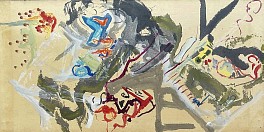BIOGRAPHY

American, 1913-2003
The story of the post-WWII New York School painters is still being written. A well-timed show at the Denver Art Museum several years ago explored the contribution of the "Women of Abstract Expressionism"--figures such as Elaine DeKooning, Joan Mitchell and Grace Hartigan but also less well-known names. One of those artists is Vivian Springford.
Born into a socially prominent family--indeed, she was a debutante--Springford chose to become a painter. She was championed in the late 1950s by Howard DeVree, the New York Times art critic, and Harold Rosenberg helped Springford get her first show at Great Jones Gallery in 1960. The show generated much excitement and was filmed in the movie “Bowl of Cherries”, in the film library of the Museum of Modern Art. Prominent collectors such as Leon Mnuchin purchased paintings from the exhibition.
Her early work was much influenced by Chinese calligraphy, a fact noted by the critics of the time. One critic wrote:
"Springford’s works evokes the feeling of some primeval or post-atomic chaos, or perhaps a conflict of the mind inexpressible in words. I saw darkness and fire and motion there…”
By 1970 Springford had developed a manner of stain painting that was distinctively her own. Her use of thinned paint on raw or thinly-primed canvas, which she developed with her calligraphic paintings of the late 1950s, developed into more abstract and wash-like marks, with stained colored lines expanding into floods of color. This stylistic approach aligns with the Color Field painters’ exploration of stain painting as a primary mode of mark-making.
Later in life, Springford would develop macular degeneration and become a recluse. In 1998, a volunteer from United-Neighbors-of-the-East-Side, which works with New York City's elderly "shut-ins", was visiting with Springford and learned about a storage room in Chelsea that held her life's work. They visited the room and found more than 40 years worth of paintings and drawings covered in plastic and a decades worth of dust since the room was last opened. The volunteer brought samples of Springford's work to Gary Snyder, an art dealer known for his revisionist exhibitions of historically rooted art and artists. Snyder immediately recognized its importance and began the process of cleaning, restoring, and showing her work. Snyder's first exhibition of Springford's work in 1998 was nearly sold out before its opening.
The NYT critic Grace Glueck wrote about her work:
"Her strong sense of color is tempered by an Asian feeling for delicate, calligraphic line, seen in works of the 1960's. These exuberant linear scribblings and doodlings, stained and painted on paper or canvas, are enhanced and sometimes almost overcome by areas of black paint, worked onto the surface by stain, brushing or other means."
